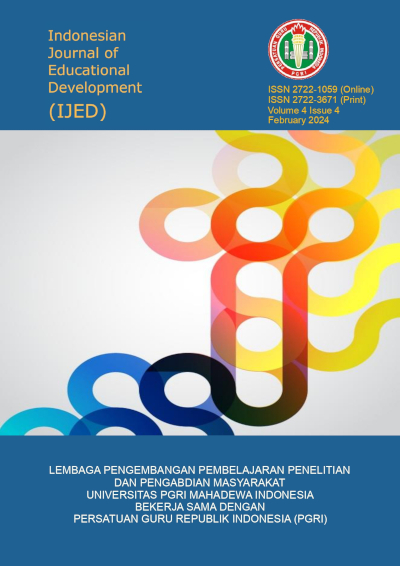AUTHENTIC ASSESSMENT IN ACTION: ENGLISH TEACHERS’ PERCEPTION AND PRACTICES FOR ASSESSING STUDENTS’ PRODUCTIVE SKILLS AT SENIOR HIGH SCHOOL
DOI:
https://doi.org/10.59672/ijed.v5i3.4219Keywords:
English teachers’ perception and practice, Authentic Assessment, Students ‘Productive SkillsAbstract
This study explores how English teachers’ perceptions and practices of authentic assessment for assessing students’ productive skills at Senior High School 2 Kuta. Using Qualitative research aims to explore in-depth information on various responses. This research is the result of expressing a person's various thoughts about a topic (McCarthy, 2017). The result revealed teachers believe that the design and implementation of authentic assessments are critical for effectively improving students' productive skills and that these assessments should fit with the Merdeka Curriculum's learning objectives. Teachers acknowledge that authentic assessments have a beneficial impact on student's ability to apply skills in real-life circumstances, and they emphasize the importance of planning and implementation in achieving good assessment outcomes.
Downloads
References
Astawa, N. L. P. N. S. P., Artini, L. P., & Nitiasih, P. K. (2017). Project-based learning activities and efl students’ productive skills in english. Journal of Language Teaching and Research, 8(6), 1147–1155. https://doi.org/10.17507/jltr.0806.16
Aziz, M. N. A., Yusoff, N. M., & Yaakob, M. F. M. (2020). Challenges in using authentic assessment in 21st century ESL classrooms. International Journal of Evaluation and Research in Education, 9(3), 759–768. https://doi.org/10.11591/ijere.v9i3.20546
Bagus, I., & Nyudak, G. (2024). Implementing Flipped Learning Strategy In Efl Writing Class At Smp Negeri 4 Mengwi Master Program Of English Language Education.
Butakor, P., & Ceasar, J. (2021). Analysing Ghanaian teachers’ perceived effects of authentic assessment on student performance in Tema Metropolis. International Journal of Curriculum and Instruction Butakor & Ceasar/ International Journal of Curriculum and Instruction, 13(3), 1947. https://files.eric.ed.gov/fulltext/EJ1312576.pdf
Chamdani, M., Salimi, M., & Fajari, L. E. W. (2022). Perceptions of first-year students in online lectures in the covid-19 pandemic era viewed from learning motivation. Pegem Egitim ve Ogretim Dergisi, 12(2), 179–192. https://doi.org/10.47750/pegegog.12.02.18
Citrawan, I. W., Widana, I. W., Sumandya, I. W., Widana, I. N. S., Mukminin, A., Arief, H., Razak, R. A., Hadiana, D., & Meter, W. (2024). Special education teachers’ ability in literacy and numeracy assessments based on local wisdom. Jurnal Ilmiah Ilmu Terapan Universitas Jambi, 8(1), 145-157. https://doi.org/10.22437/jiituj.v8i1.32608
Havnes, A., & McDowell, L. (2007). Balancing dilemmas in assessment and learning in contemporary education. Balancing Dilemmas in Assessment and Learning in Contemporary Education, January 2007, 1–295. https://doi.org/10.4324/9780203942185
Huang, R., & Jiang, L. (2021). Authentic assessment in Chinese secondary English classrooms: teachers’ perception and practice. Educational Studies, 47(6), 633–646. https://doi.org/10.1080/03055698.2020.1719387
Imansyah, I., Utama, I. M. P., & Sumarni, B. (2018). An analysis on the EFL teachers’ perception about authentic assessment. VELES Voices of English Language Education Society, 2(2), 98–104. https://doi.org/10.29408/veles.v2i2.845
Maisani, R., Tahrun, T., & Mulyadi, M. (2022). Digital learning of English: EFL learners’ perceptions and teaching activities. Journal of English Language and Education, 7(2), 36–43. https://doi.org/10.31004/jele.v7i2.281
Majeed, A. C. T., & Ilankumaran, M. (2022). Teaching language skills in the ESL classroom through programmed instruction. International Journal of Health Sciences, 6(8), 4803–4822. https://doi.org/10.53730/ijhs.v6ns6.11465
McCarthy, J. M., Bauer, T. N., Truxillo, D. M., Anderson, N. R., Costa, A. C., & Ahmed, S. M. (2017). Applicant Perspectives During Selection: A Review Addressing “So What?,” “What’s New?,” and “Where to Next?” Journal of Management, 43(6), 1693–1725. https://doi.org/10.1177/0149206316681846
Nayman, H., & Bavlı, B. (2022). Online teaching of productive language skills (PLS) during emergency remote teaching (ERT) in EFL classrooms: A phenomenological inquiry. International Journal of Education and Literacy Studies, 10(1), 179. https://doi.org/10.7575/aiac.ijels.v.10n.1p.179
Nguyen, T. T. K., & Phan, H. M. (2020). Authentic assessment: A real life approach to writing skill development. International Journal of Applied Research in Social Sciences, 2(1), 20–30. https://doi.org/10.51594/ijarss.v2i1.97
Rukmini, D., & Saputri, L. A. D. E. (2017). The authentic assessment to measure students’ English productive skills based on 2013 curriculum. Indonesian Journal of Applied Linguistics, 7(2), 263–273. https://doi.org/10.17509/ijal.v7i2.8128
Samaie, M., & Valizadeh, P. (2023). The gap between teaching, assessment, and learning: EFL teachers’ perceptions and strategies. Language Testing in Focus: An International Journal, 7(7), 12–27. https://doi.org/10.32038/ltf.2023.07.02
Sukendra, I. K., Surat, I. M., & Widana, I.W. (2024). Student worksheets and the level of students' confidence in solving the HOTS questions. Indonesian Research Journal in Education |IRJE|, 8(1), 363 – 373. https://doi.org/10.22437/irje.v8i1.28825
Widana, I. W. & Ratnaya, I. G. (2021). Relationship between divergent thinking and digital literacy on teacher ability to develop HOTS assessment. Journal of Educational Research and Evaluation, 5(4), 516-524. https://doi.org/10.23887/jere.v5i4.35128
Yanti, M. S. (2020). English Teachers’ Perception on Using Authentic Assessment Based on 2013 Curriculum in the Secondary School Level. 508(Icite), 311–317. https://doi.org/10.2991/assehr.k.201214.254
Downloads
Published
How to Cite
Issue
Section
License
Copyright (c) 2024 Ni Luh Eka Setiawati, Ni Putu Era Marsakawati, Dewa Putu Ramendra

This work is licensed under a Creative Commons Attribution 4.0 International License.
This is an Open Access article distributed under the terms of Creative Commons Attribution 4.0 International License, which permits use, sharing, adaptation, distribution and reproduction in any medium or format, as long as you give appropriate credit to the original author(s) and the source, provide a link to the Creative Commons licence, and indicate if changes were made. The images or other third party material in this article are included in the article's Creative Commons licence, unless indicated otherwise in a credit line to the material.

















